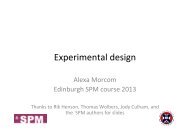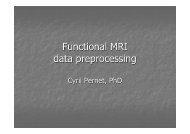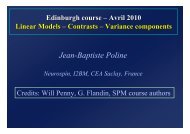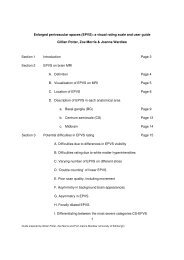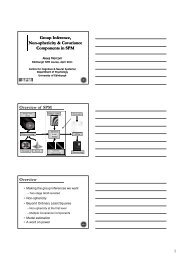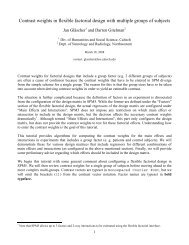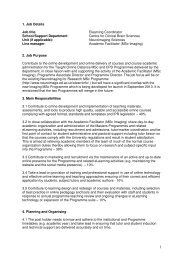Centre for In Vivo Imaging Sciences - Brain Research Imaging ...
Centre for In Vivo Imaging Sciences - Brain Research Imaging ...
Centre for In Vivo Imaging Sciences - Brain Research Imaging ...
You also want an ePaper? Increase the reach of your titles
YUMPU automatically turns print PDFs into web optimized ePapers that Google loves.
Date of submission: 31 October 2012<br />
Project title: 12<br />
Applicant: Val Brunton<br />
1<br />
<strong>Centre</strong> <strong>for</strong> <strong>In</strong> <strong>Vivo</strong> <strong>Imaging</strong> <strong>Sciences</strong><br />
PhD Project Proposal Template <strong>for</strong> PhDs starting in 2013<br />
<strong>Centre</strong> (i.e. primary facility/centre/unit to which this studentship will be attached*):<br />
Edinburgh Cancer <strong>Research</strong> <strong>Centre</strong>, University of Edinburgh<br />
First supervisor: contact details<br />
Name: Dr Val Brunton<br />
Department: Edinburgh Cancer <strong>Research</strong> <strong>Centre</strong><br />
Address: Edinburgh Cancer <strong>Research</strong> <strong>Centre</strong>, University of Edinburgh, Crewe Road South,<br />
Edinburgh, EH4 2XR<br />
Email: v.brunton@ed.ac.uk phone: 0131 777 3556<br />
Second supervisor: contact details<br />
Name: Dr Alison Hulme<br />
Department: School of Chemistry<br />
Address: School of Chemistry, University of Edinburgh, Kings Buildings, West Mains Road,<br />
Edinburgh, EH9 3JJ<br />
Email: Alison.Hulme@ed.ac.uk phone: 0131 650 4711<br />
Speciality/discipline of first supervisor:<br />
Cancer cell biology, intravital imaging,<br />
mouse models of cancer<br />
Speciality/discipline of second supervisor:<br />
Chemical Biology, organic synthesis,<br />
medicinal chemistry<br />
PROJECT<br />
Title:<br />
Development of high speed Raman imaging techniques to aid preclinical drug development<br />
Likely background of suitable student (eg. Biomedical Science, Cardiovascular Biology,<br />
Engineering, <strong>In</strong><strong>for</strong>matics, Image Analysis, Mathematics, Lay, Art, Neuroscience, Medical<br />
Physics, Chemistry, Psychology) and essential skills required prior to starting this PhD:<br />
This project requires a student with a keen interest in interdisciplinary science. The student<br />
will have studied a Biomedical <strong>Sciences</strong>, Chemistry, Medicinal Chemistry, or Biochemistry<br />
(or related) degree programme.<br />
The student would require:<br />
A basic knowledge of chemistry or biochemistry; ideally with laboratory experience in the<br />
synthesis and handling of small molecules.<br />
Experience in the handling of cells and/or live animals.<br />
Spectroscopic understanding; ideally with some experience of imaging and/or microscopy.<br />
*usually this would be the university in which the first supervisor is based.<br />
Once completed, please return to<br />
Mrs Moira Henderson – civis.enquiry@ed.ac.uk
Date of submission: 31 October 2012<br />
Project title: 12<br />
Applicant: Val Brunton<br />
2<br />
Summary of proposed project (approximately 200 words):<br />
Drug attrition rates in oncology are dismal (5%) and new approaches are required to optimise<br />
the use of novel therapeutics. Drug delivery and retention within tumours is extremely<br />
important when considering responses to therapy but is not routinely measured as traditional<br />
imaging technologies require the use of bulky labels which frequently interfere with drug<br />
function. Coherent Anti-stokes Raman Scattering (CARS) is a <strong>for</strong>m of fast acquisition Raman<br />
spectroscopy that allows label-free visualisation based on the vibration of particular chemical<br />
species. However, problems with non-resonant background signals using CARS reduces its<br />
applicability. Stimulated Raman Scattering (SRS), a new variant of CARS, provides more<br />
sensitive optical imaging, and should also provide a quantitative measure of intra-tumoural<br />
drug concentration 1,2 . Alkynes avoid many of the pitfalls of other labelling technologies: they<br />
are small, unreactive in cellular environments, can be introduced using a range of<br />
chemistries thus ensuring drug function is retained, and can be imaged at a wavelength that<br />
falls in the Raman silent region of a cell. However, their potential as labels <strong>for</strong> both small<br />
molecule drugs and antibody therapeutics <strong>for</strong> imaging purposes has yet to be exploited 3 .<br />
This project will assess the ability of SRS (with or without alkyne labelling) to determine<br />
intra-tumoural concentrations of HER2 targeted therapies (including the antibody<br />
trastuzumab and small molecule kinase inhibitors) and establish its utility in monitoring drug<br />
biodistribution in mouse models to address whether it will provide a new approach to<br />
preclinical ‘pharmaco-kinetic’ drug analysis. This will be made possible by using optical<br />
windows <strong>for</strong> intra-vital imaging that permits longitudinal imaging following drug treatment 4,5 .<br />
Key references (up to five):<br />
1. Mouras R, Rischitor G, Downes A, Salter D, Elfick A (2010) Nonlinear optical microscopy <strong>for</strong> drug<br />
delivery monitoring and cancer tissue imaging. J Raman Spectrosc 41: 848-852<br />
2. Saar BG, Freudiger CW, Reichman J, Stanley CM, Holtom GR, Xie XS (2010) Video-rate molecular<br />
imaging in vivo with stimulated Raman scattering. Science 330: 1368-1370<br />
3. Yamakoshi H, Dodo K, Okada M, Ando J, Palonpon A, Fujita K, Kawata S, Sodeoka M (2011)<br />
<strong>Imaging</strong> of EdU, an Alkyne-Tagged Cell Proliferation Probe, by Raman Microscopy. J Am Chem Soc<br />
133: 6102-6105<br />
4. Canel M, Serrels A, Miller D, Timpson P, Serrels B, Frame MC, Brunton VG (2010) Quantitative in<br />
vivo imaging of the effects of inhibiting integrin signalling via Src and FAK on cancer cell movement;<br />
effects on E-cadherin dynamics. Cancer Res 70: 9413-22<br />
5. Canel M, Serrels A, Anderson KI, Frame MC, Brunton VG (2010) Use of photoactivation and<br />
photobleaching to monitor the dynamic regulation of E-cadherin at the plasma membrane. Cell Adh<br />
Migr 4: 491-501<br />
<strong>In</strong> what way does this PhD proposal meet the CIVIS criteria as described in the call <strong>for</strong><br />
proposals? (50 words)<br />
This is a multi-disciplinary project and builds on an existing collaboration between Dr Brunton<br />
and Dr Andy Downes (CSE). It now brings together cancer biologists chemists and engineers<br />
to develop high speed Raman microscopy technologies, which we believe will have a<br />
significant impact on preclinical drug development.<br />
Please state which scheme your proposal should be considered <strong>for</strong>:<br />
If you are unsure please discuss with named individual.<br />
x UoE CMVM (Prof J Wardlaw, Prof I Marshall, Prof M Holmes, Prof E van Beek)<br />
UoE CHSS PPLS Psychology (Prof R Logie)<br />
UoE CSE <strong>In</strong><strong>for</strong>matics DTC (Prof D Robertson)<br />
HWU Engineering (Prof Rory Duncan)<br />
Once completed, please return to<br />
Mrs Moira Henderson – civis.enquiry@ed.ac.uk



